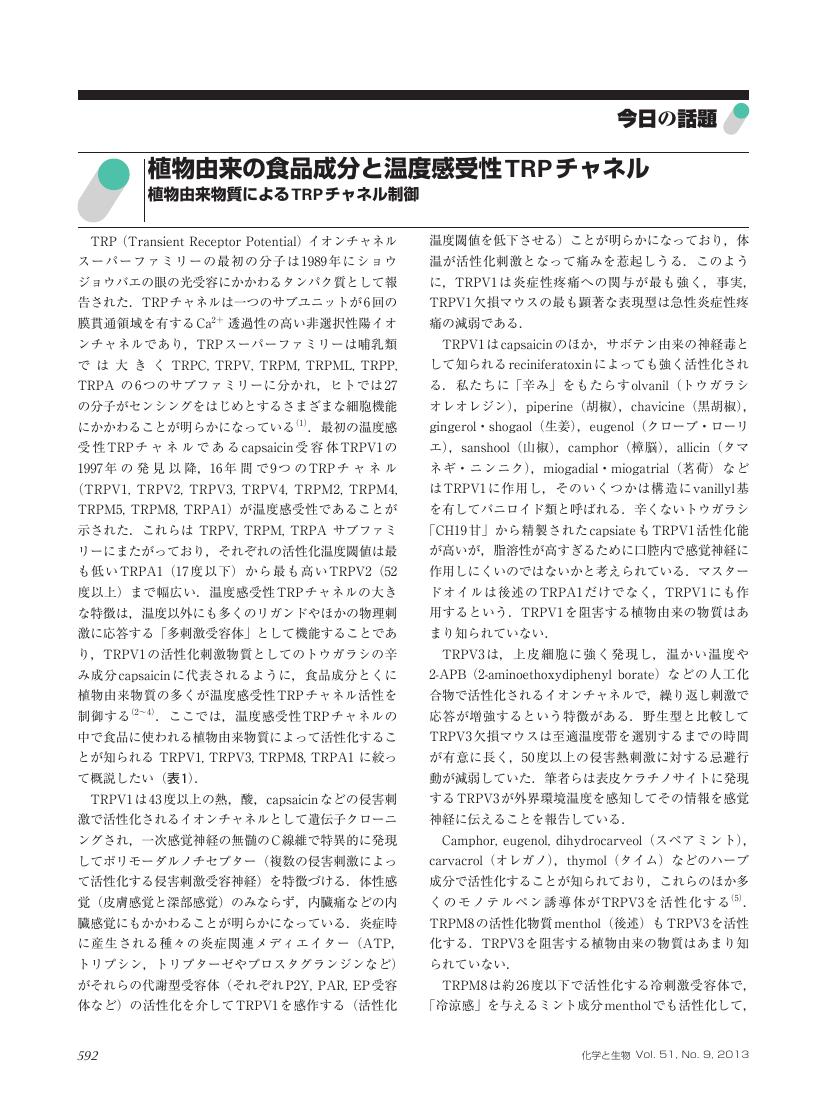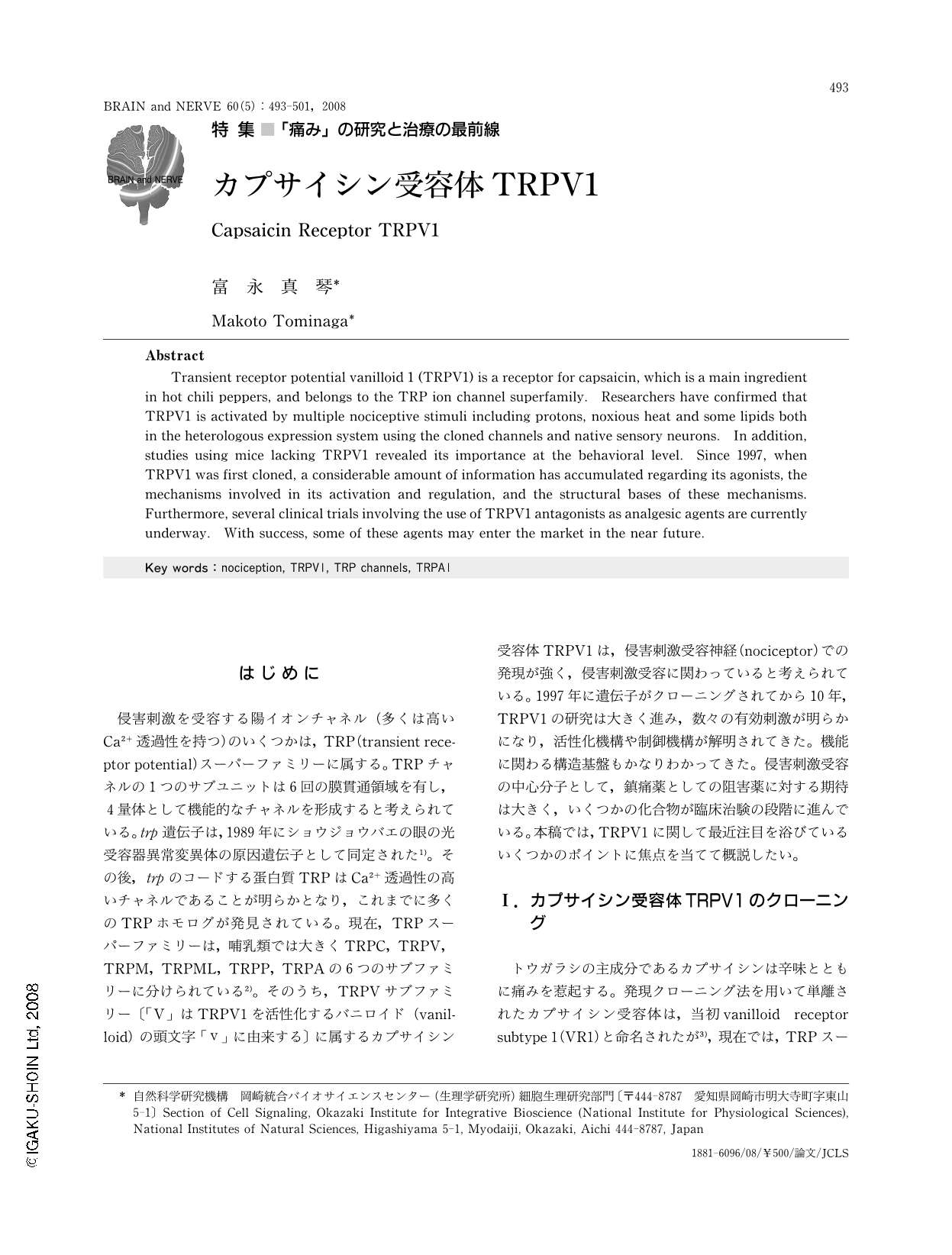48 0 0 0 OA TRPチャネルと痛み
- 著者
- 富永 真琴
- 出版者
- 公益社団法人 日本薬理学会
- 雑誌
- 日本薬理学雑誌 (ISSN:00155691)
- 巻号頁・発行日
- vol.127, no.3, pp.128-132, 2006 (Released:2006-05-01)
- 参考文献数
- 27
- 被引用文献数
- 3 3
TRPチャネルは6回の膜貫通領域を有する陽イオンチャネルであり,4量体として機能すると考えられている.また,大きなスーパーファミリーを形成し,哺乳類では6つのサブファミリーに分かれている.カプサイシン受容体TRPV1は1997年にクローニングされ,感覚神経特異的に発現し,カプサイシンのみならず私達の身体に痛みをもたらすプロトン,熱によっても活性化される多刺激痛み受容体として機能することが,TRPV1発現細胞やTRPV1遺伝子欠損マウスを用いた解析から明らかにされた.さらに,TRPV1は炎症関連メディエイター存在下でPKCによるリン酸化によってその活性化温度閾値が体温以下に低下し,体温で活性化されて痛みを惹起しうることが分かった.このTRPV1の機能制御機構は急性炎症性疼痛発生の分子機構の1つと考えられている.カプサイシンは逆説的に鎮痛薬としても使われているが,その作用メカニズムの一つとしてTRPV1の脱感作機構が考えられている.痛みを惹起する刺激(温度刺激,機械刺激,化学刺激)のうち,温度刺激による痛みはおよそ43度以上あるいは15度以下で起こるとされている.TRPV1は初めて分子実体の明らかになった温度受容体であり,現在までに8つの温度感受性TRPチャネルが報告されている.侵害刺激となる温度によって活性化するTRPV1,TRPV2,TRPA1は侵害温度刺激受容に関与するものと思われる.感覚神経に発現する他の温度感受性あるいは機械刺激感受性TRPチャネルも侵害刺激受容に関わる可能性が考えられている.これらの侵害刺激受容TRPチャネルは,新たな鎮痛薬開発のターゲットとして注目される.
9 0 0 0 OA 消化管におけるTRPV1の発現と機能
- 著者
- 富永 真琴
- 出版者
- 公益社団法人 日本薬理学会
- 雑誌
- 日本薬理学雑誌 (ISSN:00155691)
- 巻号頁・発行日
- vol.128, no.2, pp.78-81, 2006 (Released:2006-08-31)
- 参考文献数
- 16
カプサイシン受容体TRPV1は1997年にクローニングされ,感覚神経特異的に発現し,カプサイシンのみならず私達の身体に痛みをもたらすプロトンや熱によっても活性化される多刺激痛み受容体として機能することが,TRPV1発現細胞やTRPV1遺伝子欠損マウスを用いた解析から明らかにされた.さらに,TRPV1は炎症関連メディエイター存在下でPKCによるリン酸化によってその活性化温度閾値が体温以下に低下し,体温で活性化されて痛みを惹起しうることが分かった.このTRPV1の機能制御機構は急性炎症性疼痛発生の分子機構の1つと考えられている.TRPV1は消化管の感覚神経にも多く発現することが明らかになっているが,消化管では疼痛発生以外に粘膜保護などの消化管の生理的機能に深く関わることが明らかになりつつあり,それは長い歴史をもつトウガラシの消化管機能への影響に関する研究成果を説明する.TRPV1やTRPV1発現神経の消化管機能制御の詳細な作用メカニズムの解明が待たれている.
8 0 0 0 OA 温度受容の分子機構
- 著者
- 富永 真琴
- 出版者
- 公益社団法人 日本薬理学会
- 雑誌
- 日本薬理学雑誌 (ISSN:00155691)
- 巻号頁・発行日
- vol.124, no.4, pp.219-227, 2004 (Released:2004-10-01)
- 参考文献数
- 50
- 被引用文献数
- 11 8 10
日本に暮らす私たちは1年を通して四季折々様々な温度を感じて過ごしており,さらに,約43度以上と約15度以下は温度感覚に加えて痛みをもたらすと考えられている.私たちはそれらの温度を感じ,意識的・無意識的にそれに対応して熱の喪失や産生等を行っている.外界の温度受容の場合,末梢感覚神経が温度刺激を電気信号(活動電位)に変換してその情報が中枢へと伝達されると考えられているが,温度受容に関わる分子として,哺乳類では6つのTRPチャネル;TRPV1(VR1),TRPV2(VRL-1),TRPV3,TRPV4,TRPM8(CMR1),TRPA1(ANKTM1)が知られており,それぞれに活性化温度閾値が存在する(TRPV1>43度,TRPV2>52度,TRPV3>32-39度,TRPV4>27-35度,TRPM8<25-28度,TRPA1<17度).TRPV1,TRPV4とTRPM8は,その活性化温度閾値が一定でなく変化しうる.TRPV1の活性化温度閾値は代謝型受容体との機能連関によって30度近くまで低下し,体温が活性化刺激となって痛みを惹起しうる.これらの温度感受性TRPチャネルは感覚神経に多く発現しているが,皮膚表皮細胞等ほかの部位に発現しているものもある.この6つの温度感受性TRPチャネルのうち,TRPV1,TRPV2,TRPA1は温度刺激による痛み受容にも関与していると思われる.身近でありながらほとんど明らかでなかった温度受容のメカニズムが受容体分子の発見ととも明らかになりつつある.
5 0 0 0 OA カプサイシン受容体:熱・プロトンで活性化されるイオンチャネル
- 著者
- 富永 真琴 Michael J. CATERINA Tobias A. ROSEN David JULIUS
- 出版者
- 一般社団法人 日本生物物理学会
- 雑誌
- 生物物理 (ISSN:05824052)
- 巻号頁・発行日
- vol.39, no.3, pp.159-164, 1999-05-25 (Released:2000-04-12)
- 参考文献数
- 19
- 被引用文献数
- 1 1
Capsaicin, the main pungent ingredient in 'hot' chili peppers, elicits burning pain by activating specific (vanilloid) receptors on sensory nerve endings. We have isolated a functional cDNA encoding a capsaicin receptor from sensory neurons using an expression cloning strategy. The cloned vanilloid receptor (VR1) is a nonselective cation channel with six transmembrane domains that is structurally related to a member of the TRP family. VR1 is also activated by increases in temperature in the nonoxious range (>43 °C. We also find that protons decrease the temperature threshold for VR1 activation such that even moderately acidic conditions (pH
4 0 0 0 OA インフルエンザ流行期における糖尿病の超過死亡
- 著者
- 富永 真琴 山谷 恵一 原 正雄 佐々木 英夫 大島 健次郎
- 出版者
- 一般社団法人 日本糖尿病学会
- 雑誌
- 糖尿病 (ISSN:0021437X)
- 巻号頁・発行日
- vol.20, no.2, pp.174-179, 1977-03-31 (Released:2011-08-10)
- 参考文献数
- 12
糖尿病と感染症の関係を知るために, インフルエンザ流行期に糖尿病死亡が増加するかどうかを人口動態統計の資料を用いて検討した. 近年, インフルエンザ流行の時期と規模の客観的指標として, また, その慢性疾患への影響の指標として, 超過死亡という概念が欧米諸国, WHOで慣行化されており, 今回この方法を用い, インフル満ンザ流行期を推定し, その流行期における糖尿病の超過死亡について検討した. 超過死亡は実際の死亡と非流行期の死亡から予測される期待死亡との差で求められる. 月別期待死亡率は月別死亡率 (観察値) を人口動態統計より得て, Serflingの方法に準じ, y=a+bt+csin (πt/6-θ) の予測式の係数を最小二乗法で求めることにより得られる. 超過死亡率の有意さの程度は比較強度 (超過死亡率/標準偏差) で検討した. インフルエンザ流行期の推定には呼吸器感染症の超過死亡で検討し, 1961年~1974年の14年間に7回の流行を把握した. この流行期に糖尿病の超過死亡は3回に有意, 1回にほぼ有意であることを認めた. 一方, 臨床的には1975年~1976年冬のインフルエンザ流行期に感冒様症状を呈した糖尿病外来患者の約70%に空腹時血糖値の上昇を認めた. したがってインフルエンザに対し糖尿病患者はhigh riskgroup (高危険群) であり, インフルエンザへの対策は糖尿病の管理上重要であると考えられる
3 0 0 0 OA 刺激感受性:温度感受性TRPチャネルの生理機能
- 著者
- 富永 真琴
- 出版者
- 日本香粧品学会
- 雑誌
- 日本香粧品学会誌 (ISSN:18802532)
- 巻号頁・発行日
- vol.36, no.4, pp.296-302, 2012-12-31 (Released:2013-12-20)
- 参考文献数
- 18
- 被引用文献数
- 1
Sensing temperature is essential for organismal survival and efficient metabolism, and now we know that TRP (transient receptor potential) channels are important for detecting ambient temperatures in many species. TRP channels were first described in Drosophila in 1989, and in mammals, TRP channels comprise six related protein families (TRPC, TRPV, TRPM, TRPA, TRPML, TRPP). One subunit of the TRP channel is composed of six transmembrane domains and a putative pore region with both amino and carboxyl termini on the cytosolic side. TRP channels are best recognized for their contributions to sensory transduction, responding to temperature, nociceptive stimuli, touch, osmolarity, pheromones and other stimuli from both within and outside the cell. Among the huge TRP super family of ion channels, some have been proven to be involved in thermosensation detecting ambient temperatures from cold to hot. There are now nine thermosensitive TRP channels (TRPV1, TRPV2, TRPV3, TRPV4, TRPM2, TRPM4, TRPM5, TRPM8 and TRPA1) with distinct temperature thresholds for their activation. Thermosensitive TRP channels work as ‘multimodal receptors’ which respond to various chemical and physical stimuli. TRPV1, the first identified thermosensitive TRP channel, was found as a receptor for capsaicin in 1997, and later was found to have thermosensitivity. I would like to describe the physiological significance of the thermosensitive TRP channels.
3 0 0 0 OA 1.神経生理学から視た痒みの実態 ―TRPチャネルと痒み―
- 著者
- 富永 真琴
- 出版者
- 一般社団法人 日本アレルギー学会
- 雑誌
- アレルギー (ISSN:00214884)
- 巻号頁・発行日
- vol.69, no.1, pp.1-6, 2020 (Released:2020-02-12)
- 参考文献数
- 26
- 著者
- 木田 尚子 曽我部 隆彰 加塩 麻紀子 須賀 康 金丸 晶子 大場 愛 富永 真琴
- 出版者
- 日本化粧品技術者会
- 雑誌
- 日本化粧品技術者会誌 (ISSN:03875253)
- 巻号頁・発行日
- vol.47, no.2, pp.108-118, 2013-06-20 (Released:2015-08-25)
- 参考文献数
- 32
われわれヒトの皮膚温度は気温や体温によって大きく変動する。しかし,温度が皮膚機能に与える影響やその詳細なメカニズムは不明である。本研究では,生理的皮膚温度付近 (>30°C) の熱刺激や化学的刺激によって活性化する温度感受性イオンチャネルTRPV4に着目し,皮膚機能におけるその役割を検証した。その結果,TRPV4はヒト表皮ケラチノサイトにおいて細胞間接着構造adherens-junction (AJ) を構成するタンパク質βカテニン,Eカドヘリンと複合体を形成し,TRPV4を活性化する熱刺激や化学的刺激を加えることで①細胞内カルシウムイオン (Ca2+) 濃度の上昇,②低分子GTP結合タンパク質Rhoの活性促進,③細胞間接着構造AJおよびtight-junction (TJ) の形成・成熟促進とそれらを介した表皮細胞間バリア機能の亢進に関わることが示唆された。さらに,TRPV4を活性化する素材の開発はバリア機能の維持・改善に有用であると考え,天然由来物からTRPV4活性化成分を探索したところ,バナバ葉から単離されたエラグ酸誘導体に高いTRPV4活性化作用および表皮細胞間バリア機能向上作用が確認された。
2 0 0 0 辛味のリセプター
- 著者
- 富永 真琴
- 出版者
- 日本味と匂学会
- 雑誌
- 日本味と匂学会誌 = The Japanese journal of taste and smell research (ISSN:13404806)
- 巻号頁・発行日
- vol.7, no.2, pp.191-196, 2000-08-01
- 被引用文献数
- 2
辛味は、トウガラシの主成分である脂溶性のカプサイシンが三叉神経終末に発現するイオンチャネル型のカプサイシン受容体VR1に結合してカチオン流入から神経興奮が起こることによって知覚される。カプサイシン受容体は感覚神経C線維にのみ発現して辛味を惹起するカプサイシンのみならず痛み刺激であるプロトンや43度以上の熱によっても活性化される多刺激痛み受容体として機能する。遺伝子クローニングされたこの受容体の機能は強制発現系での電気生理学的な解析に加えて受容体欠損マウスの行動解析からも確かめられた。
- 著者
- 富永 真琴
- 出版者
- 公益社団法人 日本薬理学会
- 雑誌
- 日本薬理学雑誌 (ISSN:00155691)
- 巻号頁・発行日
- vol.124, no.4, pp.219-227, 2004
- 被引用文献数
- 5 8
日本に暮らす私たちは1年を通して四季折々様々な温度を感じて過ごしており,さらに,約43度以上と約15度以下は温度感覚に加えて痛みをもたらすと考えられている.私たちはそれらの温度を感じ,意識的・無意識的にそれに対応して熱の喪失や産生等を行っている.外界の温度受容の場合,末梢感覚神経が温度刺激を電気信号(活動電位)に変換してその情報が中枢へと伝達されると考えられているが,温度受容に関わる分子として,哺乳類では6つのTRPチャネル;TRPV1(VR1),TRPV2(VRL-1),TRPV3,TRPV4,TRPM8(CMR1),TRPA1(ANKTM1)が知られており,それぞれに活性化温度閾値が存在する(TRPV1>43度,TRPV2>52度,TRPV3>32-39度,TRPV4>27-35度,TRPM8<25-28度,TRPA1<17度).TRPV1,TRPV4とTRPM8は,その活性化温度閾値が一定でなく変化しうる.TRPV1の活性化温度閾値は代謝型受容体との機能連関によって30度近くまで低下し,体温が活性化刺激となって痛みを惹起しうる.これらの温度感受性TRPチャネルは感覚神経に多く発現しているが,皮膚表皮細胞等ほかの部位に発現しているものもある.この6つの温度感受性TRPチャネルのうち,TRPV1,TRPV2,TRPA1は温度刺激による痛み受容にも関与していると思われる.身近でありながらほとんど明らかでなかった温度受容のメカニズムが受容体分子の発見ととも明らかになりつつある.<br>
1 0 0 0 OA 温度感受性TRPM2チャネルの活性制御機構と免疫応答への関与の解析
- 著者
- 富永 真琴
- 出版者
- 大学共同利用機関法人自然科学研究機構(岡崎共通研究施設)
- 雑誌
- 基盤研究(A)
- 巻号頁・発行日
- 2011-04-01
マウス腹腔の肥満細胞の温度感受性TRPM2チャネルが消化管の機能を調節していることが分かった。また、過酸化水素によってTRPM2の熱活性化温度閾値が低下(感作)して機能増強につながることが明らかになり、酸化されるTRPM2のメチオニン残基を同定した。この増強機構はマウス腹腔マクロファージのサイトカインの産生や微少な温度上昇による貪食能の増強に関与することが分かった。さらに、このTRPM2の感作機構がマウス膵臓β細胞からのグルコース依存性のインスリン分泌にも関わることが判明した。
1 0 0 0 OA 温度感受性TRPチャネルと疾患
- 著者
- 富永 真琴
- 出版者
- 公益社団法人 日本薬学会
- 雑誌
- ファルマシア (ISSN:00148601)
- 巻号頁・発行日
- vol.51, no.11, pp.1047-1052, 2015 (Released:2018-08-26)
- 参考文献数
- 25
- 被引用文献数
- 1
細胞は,それを取り巻く環境の変化の中で,その環境情報を他のシグナルに変換し,細胞質・核や周囲の細胞に伝達することによって環境変化にダイナミックに対応している.細胞外環境に直接接する膜タンパク質は細胞膜センサーとして細胞感覚に重要な役割を果たしているが,特にTRPチャネルは化学物質刺激・物理刺激のセンサーとして注目を浴びている.TRPチャネルは多くの疾患と関連があることが明らかになっており,創薬標的になると同時に物理療法の標的にも成り得る.
1 0 0 0 痛み・温度を感じる (特集1 分子を感じる:感覚の分子生物学)
1 0 0 0 OA 植物由来の食品成分と温度感受性TRPチャネル 植物由来物質によるTRPチャネル制御
- 著者
- 富永 真琴
- 出版者
- 公益社団法人 日本農芸化学会
- 雑誌
- 化学と生物 (ISSN:0453073X)
- 巻号頁・発行日
- vol.51, no.9, pp.592-594, 2013-09-01 (Released:2014-09-01)
- 参考文献数
- 8
1 0 0 0 OA 鎮痒剤クロタミトンの標的分子の同定および作用メカニズムの解明
- 著者
- 橘高 裕貴 山野井 遊 富永 真琴
- 出版者
- 日本疼痛学会
- 雑誌
- PAIN RESEARCH (ISSN:09158588)
- 巻号頁・発行日
- vol.33, no.1, pp.47-57, 2018-03-30 (Released:2018-05-31)
- 参考文献数
- 24
Crotamiton (N–ethyl–o–crotonotoluidide) has long been used as an anti–itch agent. However, the mechanism by which crotamiton exerts anti–itch effects is unknown. Based on recent studies showing that transient receptor potential (TRP) channels are involved in itch sensations, we hypothesized that crotamiton could affect the activity of TRP channels. In this study, we found that crotamiton strongly inhibits TRPV (vanilloid) 4 channel activity. Crotamiton also inhibited itch–related behaviors induced by the TRPV4–selective agonist GSK1016790A. In patch–clamp experiments we observed large TRPV4 currents following crotamiton washout. In this washout current, single–channel open probabilities and unitary current amplitudes of TRPV4 were increased, which together were suggestive of TRPV4 pore dilation. To explore whether TRPV4 pore dilation occurred, we performed cation replacement experiments in which whole–cell currents and reversal potentials were measured. Our observation of increased cation influx and changes in reversal potentials upon crotamiton washout indicated the presence of TRPV4 pore dilation. These results identified TRPV4 as a molecular target of crotamiton and demonstrated pore dilation of TRPV4 upon crotamiton washout.
1 0 0 0 カプサイシン受容体TRPV1
- 著者
- 富永 真琴
- 出版者
- 医学書院
- 雑誌
- BRAIN and NERVE-神経研究の進歩 (ISSN:18816096)
- 巻号頁・発行日
- vol.60, no.5, pp.493-501, 2008-05-01
はじめに 侵害刺激を受容する陽イオンチャネル(多くは高いCa2+透過性を持つ)のいくつかは,TRP(transient receptor potential)スーパーファミリーに属する。TRPチャネルの1つのサブユニットは6回の膜貫通領域を有し,4量体として機能的なチャネルを形成すると考えられている。trp遺伝子は,1989年にショウジョウバエの眼の光受容器異常変異体の原因遺伝子として同定された1)。その後,trpのコードする蛋白質TRPはCa2+透過性の高いチャネルであることが明らかとなり,これまでに多くのTRPホモログが発見されている。現在,TRPスーパーファミリーは,哺乳類では大きくTRPC,TRPV,TRPM,TRPML,TRPP,TRPAの6つのサブファミリーに分けられている2)。そのうち,TRPVサブファミリー〔「V」はTRPV1を活性化するバニロイド(vanilloid)の頭文字「v」に由来する〕に属するカプサイシン受容体TRPV1は,侵害刺激受容神経(nociceptor)での発現が強く,侵害刺激受容に関わっていると考えられている。1997年に遺伝子がクローニングされてから10年,TRPV1の研究は大きく進み,数々の有効刺激が明らかになり,活性化機構や制御機構が解明されてきた。機能に関わる構造基盤もかなりわかってきた。侵害刺激受容の中心分子として,鎮痛薬としての阻害薬に対する期待は大きく,いくつかの化合物が臨床治験の段階に進んでいる。本稿では,TRPV1に関して最近注目を浴びているいくつかのポイントに焦点を当てて概説したい。
1 0 0 0 IR 臨床医学におけるサイエンスとアート
- 著者
- 富永 真琴
- 出版者
- 山形大学
- 雑誌
- 山形医学 (ISSN:0288030X)
- 巻号頁・発行日
- vol.27, no.1, pp.1-10, 2009-02
抄録 臨床医学はまぎれもなくサイエンスであるが、医療はアートも大きい部分を占める。筆者は「臨床の知とは何か」について中村雄二郎先生の哲学的思索に触れてみることを勧めたい。厳密物理・精密化学の進歩が万人の幸せに繋がると信じる知の在り方は、中村先生によれば「北型の知」であって、医学も含めたサイエンスの一面に過ぎない。これに対比できるのが「南型の知」で人間や自然本来の複雑性と多義性をそのまま、認めるという知の在り方である。中村先生は「臨床の知」は「南型の知」に似る、としている。一方、長い間、「ヒポクラティスの誓い」に代表される倫理観の下に医療が行われてきたが、その特徴はパターナリズムと矛盾はしなかったことである。近年の医師・患者関係の成熟により、1970年代から患者の人格を尊重する原理および医療資源の公平な配分という原理が導入されている。医療行為がサイエンスに基づく判断の下、患者に対し善行かつ無危害であったとしても、それが患者個人に関わる様々な状況にまったく配慮しない医師の独善的な判断ならば、倫理上も問題とされる。臨床医学が生身の人間を対象としている以上、サイエンスとともに、患者の人格を尊重し思いやるアートの部分も大事である。サイエンスとしての臨床医学が対象とするのは肉体であって,人格ではない。これに対して、アートとしての臨床医学が対象とするのが患者の人格であって,それは複雑性・多義性に満ちている。類型化は可能だとしても二人として全く同じ人格などあり得ない。生身の人間である患者を目の前にした時、「人は自己の存在の理由を求めている。」と斎藤武先生が述べたことを深く理解したい。医師および医療従事者は、複雑性・多義性に満ちたさまざまな患者さんに対し、鋭い洞察力、豊かな想像力そして個々の患者の人格に関する深い理解をもって、適切な医療行為を提供できるようになるため、生涯をかけ、サイエンスとアートの両方の部分に研鑽を積むことが求められている。
1 0 0 0 OA 温度を基軸とした生命現象の統合的理解
- 著者
- 富永 真琴
- 雑誌
- 新学術領域研究(研究領域提案型)
- 巻号頁・発行日
- 2015-06-29
1 0 0 0 消化管におけるTRPV1の発現と機能
- 著者
- 富永 真琴
- 出版者
- 公益社団法人 日本薬理学会
- 雑誌
- 日本薬理学雑誌 : FOLIA PHARMACOLOGICA JAPONICA (ISSN:00155691)
- 巻号頁・発行日
- vol.128, no.2, pp.78-81, 2006-08-01
カプサイシン受容体TRPV1は1997年にクローニングされ,感覚神経特異的に発現し,カプサイシンのみならず私達の身体に痛みをもたらすプロトンや熱によっても活性化される多刺激痛み受容体として機能することが,TRPV1発現細胞やTRPV1遺伝子欠損マウスを用いた解析から明らかにされた.さらに,TRPV1は炎症関連メディエイター存在下でPKCによるリン酸化によってその活性化温度閾値が体温以下に低下し,体温で活性化されて痛みを惹起しうることが分かった.このTRPV1の機能制御機構は急性炎症性疼痛発生の分子機構の1つと考えられている.TRPV1は消化管の感覚神経にも多く発現することが明らかになっているが,消化管では疼痛発生以外に粘膜保護などの消化管の生理的機能に深く関わることが明らかになりつつあり,それは長い歴史をもつトウガラシの消化管機能への影響に関する研究成果を説明する.TRPV1やTRPV1発現神経の消化管機能制御の詳細な作用メカニズムの解明が待たれている.<br>
1 0 0 0 OA 糖尿病を主な対象とした保健データ、臨床データ・医療保険情報の時系列的解析の研究
糖尿病を含む生活習慣病においては、個人の健診データと生活指導が中心で進められているが、日常生活や社会的要因が大きく影響する。今回、地方の糖尿病調査および企業従業員の経年変化を調査し比較した結果、通勤・移動、食生活の食材、生活習慣、地方と都市、経済状態など直接個人の健康状態に結びつかないように見える要因の影響が無視できないことがわかった。また、このような社会的要因を個人情報と連携させるためには、従来の医療を中心とした枠組みではなく、個人と社会や環境などの要因を含めた総合的な枠組みを構築する必要があり、その概要モデルを検討した。


